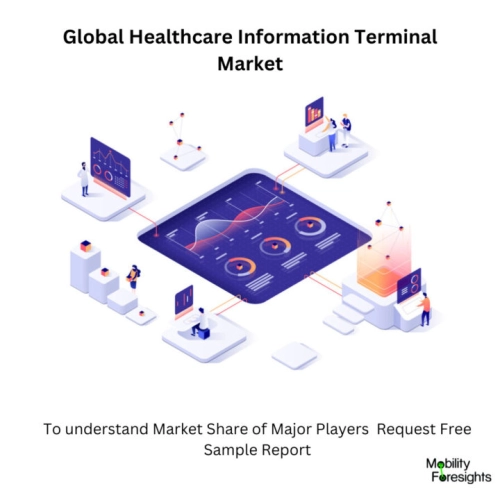
- Get in Touch with Us

Last Updated: Apr 25, 2025 | Study Period: 2024-2030
A self-service device or computer system that gives access to healthcare-related information and services is referred to as a healthcare information terminal, healthcare kiosk, or patient information kiosk.
These terminals, which are frequently found in healthcare facilities including hospitals, clinics, and medical centers, are made to improve patient participation and offer simple access to resources for improving one's health.
The features and functionalities that healthcare information terminals often offer include:
Patient Education: They offer informational materials and sources on a range of health-related subjects, including illnesses, available treatments, preventive care, and healthy living.
Patients can learn about their medical issues or procedures, as well as obtain information catered to their unique needs.
Patients can utilize the terminal to make new appointments or change existing ones with healthcare professionals.
This function lessens the administrative burden on staff and streamlines the appointment scheduling procedure.
Patients can electronically register themselves at some terminals by updating their personal information, insurance information, and medical history.
This could speed up check-in and increase the accuracy of patient data.
Refills of prescriptions may be requested by patients through the terminal, saving time and obviating the need for phone calls or physical visits to the pharmacy.
Check-in and Check-out: Patients can use the terminal to check themselves in for appointments or treatments and to finish the check-out procedure at the conclusion of their visit.
Waiting times can be cut down, and workflow efficiency can be increased.
Wayfinding and Directions: Interactive maps and directions are frequently included in healthcare information terminals to assist patients in navigating the facility and locating certain departments or clinics.
Interactive health evaluations or surveys are available on some terminals to collect data on patients' health conditions or risk factors.
This information can be utilized to make tailored recommendations or speed up triage procedures.
Depending on the provider and the intended usage, healthcare information terminals' exact features and capabilities can change.
These terminals provide self-service choices and lessen reliance on personnel for regular tasks, with the goal of empowering patients, enhancing information availability, and improving the overall healthcare experience.

The Global Healthcare Information Terminal Market accounted for $XX Billion in 2022 and is anticipated to reach $XX Billion by 2030, registering a CAGR of XX% from 2024 to 2030.
HIT-512 Medical-Grade Information Terminal for Bedside Applications is Introduced by Advantech.
Advantech, a top supplier of medical computing platforms and solutions, is happy to introduce the HIT-512, an 11.6" medical-grade healthcare information terminal that gives system integrators access to a bedside terminal that can be quickly integrated with nurse call systems.
The HIT-512 offers a dependable, high-performance device that is simple to integrate with nurse call systems.
It has an Intel® Celeron® J3455 quad-core processor and an 11.6" display with 10-point projected capacitive (P-CAP) touch control. HIT-512 terminals enable both wired and wireless connection and are compatible with Windows 10 IoT (64-bit), Android 8.1, and Linux 18.04 operating systems to ensure flexible deployment for a variety of healthcare applications.
The availability of SDKs allows medical personnel to manage terminal features including modifying the LED indicator, audio, and watchdog settings without the need for extra installation.
The HIT-512 terminal is consistent with IEC 60601 safety standards for medical devices, which for system integrators reduces the time to market by guaranteeing adherence to healthcare regulations.
| Sl no | Topic |
| 1 | Market Segmentation |
| 2 | Scope of the report |
| 3 | Abbreviations |
| 4 | Research Methodology |
| 5 | Executive Summary |
| 6 | Introduction |
| 7 | Insights from Industry stakeholders |
| 8 | Cost breakdown of Product by sub-components and average profit margin |
| 9 | Disruptive innovation in the Industry |
| 10 | Technology trends in the Industry |
| 11 | Consumer trends in the industry |
| 12 | Recent Production Milestones |
| 13 | Component Manufacturing in US, EU and China |
| 14 | COVID-19 impact on overall market |
| 15 | COVID-19 impact on Production of components |
| 16 | COVID-19 impact on Point of sale |
| 17 | Market Segmentation, Dynamics and Forecast by Geography, 2024-2030 |
| 18 | Market Segmentation, Dynamics and Forecast by Product Type, 2024-2030 |
| 19 | Market Segmentation, Dynamics and Forecast by Application, 2024-2030 |
| 20 | Market Segmentation, Dynamics and Forecast by End use, 2024-2030 |
| 21 | Product installation rate by OEM, 2023 |
| 22 | Incline/Decline in Average B-2-B selling price in past 5 years |
| 23 | Competition from substitute products |
| 24 | Gross margin and average profitability of suppliers |
| 25 | New product development in past 12 months |
| 26 | M&A in past 12 months |
| 27 | Growth strategy of leading players |
| 28 | Market share of vendors, 2023 |
| 29 | Company Profiles |
| 30 | Unmet needs and opportunity for new suppliers |
| 31 | Conclusion |
| 32 | Appendix |